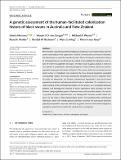Files in this item
A genetic assessment of the human-facilitated colonization history of black swans in Australia and New Zealand
Item metadata
| dc.contributor.author | Montano, Valeria | |
| dc.contributor.author | van Dongen, Wouter F.D. | |
| dc.contributor.author | Weston, Michael A. | |
| dc.contributor.author | Mulder, Raoul A. | |
| dc.contributor.author | Robinson, Randall W. | |
| dc.contributor.author | Cowling, Mary | |
| dc.contributor.author | Guay, Patrick-Jean | |
| dc.date.accessioned | 2019-08-16T12:30:02Z | |
| dc.date.available | 2019-08-16T12:30:02Z | |
| dc.date.issued | 2018-03 | |
| dc.identifier | 260615903 | |
| dc.identifier | 66d92f43-18d2-4e9b-bb46-9e1d23388904 | |
| dc.identifier | 85041084660 | |
| dc.identifier | 000429324200007 | |
| dc.identifier.citation | Montano , V , van Dongen , W F D , Weston , M A , Mulder , R A , Robinson , R W , Cowling , M & Guay , P-J 2018 , ' A genetic assessment of the human-facilitated colonization history of black swans in Australia and New Zealand ' , Evolutionary Applications , vol. 11 , no. 3 , pp. 364-375 . https://doi.org/10.1111/eva.12535 | en |
| dc.identifier.issn | 1752-4563 | |
| dc.identifier.uri | https://hdl.handle.net/10023/18322 | |
| dc.description.abstract | Movement of species beyond their indigenous distribution can fundamentally alter the conservation status of the populations involved. If introductions are human-facilitated, introduced species could be considered pests. Characterizing the colonization history of introduced species can therefore be critical to formulating the objectives and nature of wildlife management strategies. The black swan (Cygnus atratus) is native to Australia but is considered a reintroduced species in New Zealand, where the endemic population was reported extinct during the 19th century. After the reintroduction of a small number of individuals from Australia, the New Zealand population expanded unexpectedly rapidly, which was attributed to simultaneous waves of migration from Australia. An alternative, but hitherto unformalized, hypothesis is that local extant populations remained and admixed with introduced individuals. To contribute to our understanding of the reintroduction history of the species, we investigated dispersal patterns and demographic histories of seven populations from Australia and New Zealand, using population genetic inferences from a microsatellite dataset. Our results on genetic structure, dispersal rates, and demographic histories provide mixed evidence on the origin of New Zealand black swans. The hypothesis that reintroduced individuals mixed with remaining local individuals and that the subsequent dramatic population expansion may have been due to genetic rescue of the inbred indigenous population cannot be discarded and needs further investigation. | |
| dc.format.extent | 12 | |
| dc.format.extent | 586597 | |
| dc.language.iso | eng | |
| dc.relation.ispartof | Evolutionary Applications | en |
| dc.subject | Conservation | en |
| dc.subject | Cygnus atratus | en |
| dc.subject | Kakianau | en |
| dc.subject | Pest species | en |
| dc.subject | Phylopatry | en |
| dc.subject | QH301 Biology | en |
| dc.subject | QH426 Genetics | en |
| dc.subject | Agricultural and Biological Sciences(all) | en |
| dc.subject | Ecology, Evolution, Behavior and Systematics | en |
| dc.subject | Genetics | en |
| dc.subject | DAS | en |
| dc.subject.lcc | QH301 | en |
| dc.subject.lcc | QH426 | en |
| dc.title | A genetic assessment of the human-facilitated colonization history of black swans in Australia and New Zealand | en |
| dc.type | Journal article | en |
| dc.contributor.institution | University of St Andrews. School of Biology | en |
| dc.identifier.doi | https://doi.org/10.1111/eva.12535 | |
| dc.description.status | Peer reviewed | en |
This item appears in the following Collection(s)
Items in the St Andrews Research Repository are protected by copyright, with all rights reserved, unless otherwise indicated.

